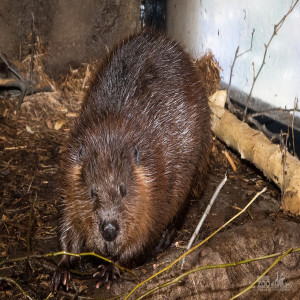American Beaver
[Castor canadensis]

American Beavers are the largest rodent in North America and one of the largest in the world. The American Beaver males and females of this species are similar. They have very dense underfur overlaid with coarse guard hairs of black, brown, yellow, or reddish brown. Their tail is paddle-shaped, flat and, covered with shiny black horny scales. It functions as a rudder and to tamp mud into place. Their tail is approximately 10 inches long and their body length is about 45 inches long with a shoulder height of 12 to 24 inches. Their weight is between 32 to 66 pounds, with newborns weighing about 1 pound. The torpedo-shaped body has short legs and black feet with 5 claws. Claws on the first 2 toes are split to aid grooming. Claws are 1 inch long for digging, and hind feet are webbed. Forepaws are designed to allow dexterity in manipulating sticks and other objects. They can sit erect, freeing paws for architectural work. Median lifespan is 7 years.
Location: Wolf Wilderness Lodge
Share:
Range
American Beavers range in the continental United States, Canada and extreme northern Mexico.
Habitat
American beavers inhabit tree-lined banks of ponds, lakes and streams.
Conservation Status
Least ConcernPrimary Threats
No major threats. Sometimes hunted for pelt.Gestation
Gestation is 100 to 110 days.
Litter
American beavers have a litter of 2 to 4.
Behavior
Beavers are rather awkward on land but are good swimmers. They have acute hearing and smell but short range vision. They are most active on summer nights, tending to sleep long hours away in winter, waking only to feed on their cache of branches fastened under water in the mud just outside their lodge. Nutrients in branches are preserved by the near freezing water. Their dams of mud, sticks, branches and stones are built across small streams at high water times, forming ponds. They construct canals between ponds by loosening mud from a marshy side and pushing it aside. Behind the dam the lodge is built of mud and branches with the main room above the water level.
Reproduction
Monogamous beaver pairs mate in January and February with litters of 2-3 coming between April and June. They live in colonies which can be several dozen members. The babies are called kits.Wild Diet
American Beavers eat bark, leaves, twigs and roots of willow, aspen, poplar trees and aquatic plants, especially water lily shoots. In spring they concentrate on non woody items and algae, eating woody items in the fall.
